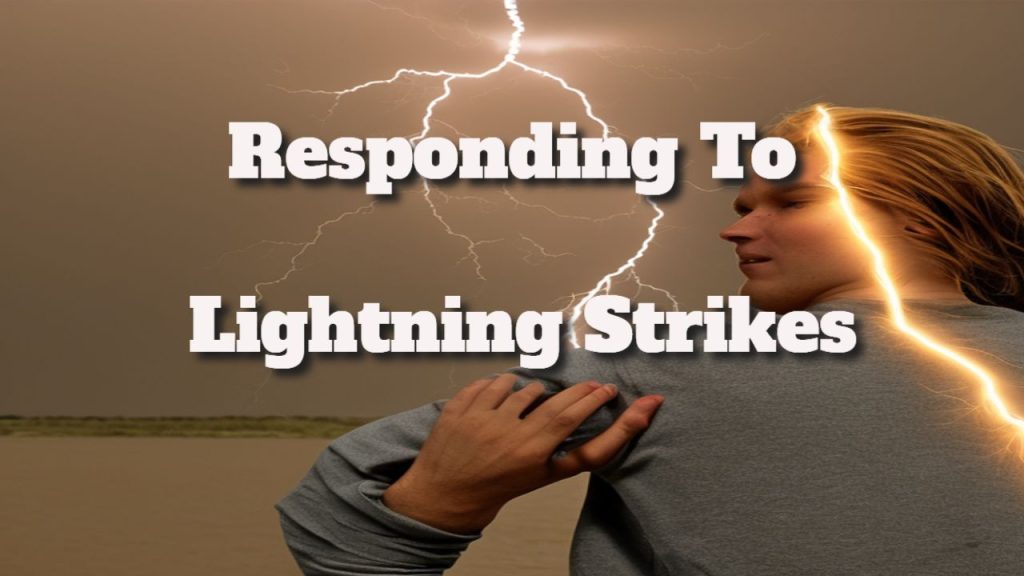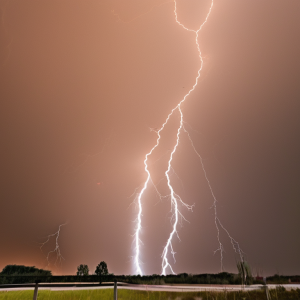Maximize Your Lightning Safety: Proven Strategies to Protect Yourself from Strikes
Decoding Lightning: Understanding Its Nature and Dangers
Lightning is not only an awe-inspiring natural phenomenon but also a formidable force that commands respect due to its power and beauty. It is essential to acknowledge the severe risks lightning poses to ensure our safety. By delving into the intricate details of lightning, we can establish a solid groundwork for effective safety measures, which will be elaborated upon in the following sections.
At its core, lightning represents a sudden release of electrical energy that occurs during thunderstorms, stemming from the buildup and discharge of static electricity within the atmosphere.
Inside thunderclouds, interactions between water droplets and ice particles cause a separation of electric charges: positively charged particles ascend to the upper regions of the cloud, while negatively charged particles accumulate at the base. This charge disparity establishes the perfect conditions for the stunning yet potentially lethal lightning storms.
Lightning appears in several forms, each exhibiting distinct characteristics. The most common form is referred to as cloud-to-ground lightning, which descends from the base of a thundercloud directly toward the earth.
This type of lightning is infamous for its devastating impact, striking with remarkable speed and intensity. Another variation, cloud-to-cloud lightning, occurs between different sections within the same storm cloud.
Cloud-to-cloud lightning often creates spectacular flashes that light up the night sky, offering a breathtaking display that captivates observers.
While the striking beauty of lightning is undeniably captivating, it is vital to maintain an awareness of the significant dangers it presents.
Lightning strikes can result in catastrophic injuries or fatalities, with thousands of people losing their lives annually due to this natural hazard.
It's crucial to understand that lightning can strike even when a storm appears distant, as electrical charges can travel extensive distances. Recognizing the dangers associated with lightning is key to enhancing our safety.
Armed with this knowledge, we can better appreciate the urgent need for proactive safety protocols. By deepening our understanding of lightning’s complexities, we equip ourselves with the necessary strategies to mitigate its associated risks.
To gain further insight into how lightning is generated, we must examine the various conditions that contribute to its formation. Thunderstorms serve as the primary instigators of lightning, providing the essential elements of moisture, unstable air, and powerful updrafts.
When these factors converge, they create the ideal conditions for remarkable electrical discharges. Thunderstorms frequently arise in warm, humid environments, where rising warm air interacts dynamically with cooler air masses.
The interplay between these contrasting air masses fosters the necessary conditions for the formation of thunderclouds, which are critical for lightning production.
The movement of air within a thundercloud is vital. Updrafts collide, allowing tiny ice particles and water droplets to interact, which leads to charge separation. This intricate process triggers a series of events that culminate in lightning.
As positive and negative charges accumulate, a strong electric field develops within the cloud. Ultimately, when this electric field reaches a critical threshold, a discharge occurs, resulting in a lightning strike.
The ability of lightning to illuminate the complex nature of our environment is truly astonishing. The various colors of lightning can indicate the composition of storm clouds.
For example, blue or purple lightning suggests the presence of ice particles, whereas yellow or red lightning may indicate dust or pollution in the cloud. By analyzing these features, meteorologists gain essential insights into the atmospheric conditions that favor lightning formation.
Despite the mesmerizing beauty of lightning, it is crucial to remain vigilant about the associated dangers of this powerful natural event. Lightning strikes occur at incredible speeds, and their destructive capabilities must not be underestimated.
In the following sections, we will examine various safety strategies that are critical for protecting ourselves in the event of a lightning strike.
By equipping ourselves with the right knowledge and implementing preventive measures, we can significantly reduce the risks and protect ourselves from lightning strikes. Join us on this enlightening journey as we uncover the secrets of lightning strike safety.
Key Lightning Safety Protocols to Reduce Strike Risks
When lightning strikes, it poses a universal threat, as this force of nature can occur suddenly and without warning, leaving little time for action.
Establishing robust safety protocols and protective measures is essential to ensure your safety during a lightning event. By doing so, we can significantly reduce the risk of being struck while also protecting those around us.
The foremost precaution during an impending thunderstorm is to remain indoors. This action offers the highest level of protection against potential lightning strikes. It's crucial to seek shelter in a sturdy building, particularly one equipped with a lightning protection system.
Avoid seeking refuge in open garages, picnic shelters, or other structures that lack adequate protection. While indoors during a thunderstorm, maintain a safe distance from windows, doors, and electronic devices.
If indoor shelter is unavailable, seek appropriate temporary refuge. Steer clear of isolated trees, wide-open fields, or large metal structures, as these can act as lightning rods, increasing your risk.
To minimize the chance of a direct strike, find a low-lying area away from potential lightning rods and lie flat, covering your ears with your hands.
Awareness of lightning safety protocols is also critical during various outdoor activities. Always check weather forecasts before participating in outdoor excursions such as hiking, golfing, or swimming.
By seeking shelter or avoiding outdoor activities during thunderstorms, you can greatly reduce your risk of being struck by lightning.
Remember, reducing your chances of being struck by lightning is vital for your safety. By staying indoors, seeking appropriate shelter, and understanding lightning safety recommendations, we can effectively protect ourselves and those around us.
However, safety measures go beyond these fundamental actions. By taking proactive steps, individuals can further diminish their risk of lightning strikes and ensure their safety during thunderstorms.
Avoiding contact with water during rainstorms is a critical safety measure. Being in or near water increases the risk of lightning strikes since water is an excellent conductor of electricity.
If you're engaged in activities like swimming or boating, exit the water immediately upon hearing thunder or seeing lightning. Remain indoors or inside a fully enclosed vehicle until the storm has passed.
Furthermore, understanding the “30-30 rule” is essential for safety during thunderstorms.
If there are fewer than 30 seconds between seeing lightning and hearing thunder, take cover immediately. It is also advisable to stay indoors for at least 30 minutes after the last flash of lightning or rumble of thunder.
Creating an action plan for outdoor sports and recreational activities is vital. Coaches, organizers, and participants should establish clear lightning safety guidelines.
In anticipation of forecasted thunderstorms, it is imperative to halt all activities and relocate everyone to a designated safe location.
To eliminate unnecessary risks, outdoor sporting events, such as golf tournaments or football games, may need to be postponed or rescheduled.
Educating children, youth, and adults about lightning safety at home and in schools is also a crucial aspect of safety planning.
Raising awareness of lightning dangers and safety practices allows individuals to make informed decisions to protect themselves during thunderstorms.
A comprehensive strategy that combines practical safety measures, precautions, and advanced strategies is vital for ensuring safety during thunderstorm events.
By avoiding water during thunderstorms, grasping the 30-30 rule, developing action plans for outdoor activities, and promoting awareness of lightning safety, we can significantly reduce the likelihood of lightning strikes.
Stay vigilant and informed, as your safety and that of those around you must always be a top priority.
Essential Response Protocols for Lightning Strike Emergencies
Lightning strikes can occur unexpectedly and pose a serious threat to our lives. Understanding the correct protocols, including first aid techniques, emergency contacts, and assisting injured individuals, is crucial in these urgent situations.
First and foremost, personal safety must be the top priority in the event of a lightning strike. If you find yourself outdoors during a thunderstorm, seek cover immediately.
Avoid wide-open spaces, tall isolated structures, and any bodies of water, as these can act as conductors for lightning. Instead, find shelter in a sturdy building or a fully enclosed vehicle with closed windows. Do not take cover under trees or in temporary structures, as these provide minimal protection.
Once you have secured a safe shelter, adhere to safety guidelines. Remember that electrical appliances, plumbing fixtures, and telephones can conduct electricity.
Avoid showering or bathing during a thunderstorm, as water is a highly effective conductor of electricity. Stay away from windows, doors, and concrete walls, which lightning can penetrate.
If someone is struck by lightning, swift action is critical. Assess the individual’s breathing and pulse. If either is absent, call 911 and initiate cardiopulmonary resuscitation (CPR) if you are trained.
Initiating resuscitation as soon as possible can significantly increase the chances of survival. If the victim is conscious but injured, provide assistance until medical aid arrives.
In the event of a lightning strike, every second counts. Stay calm, act swiftly, and ensure the safety of everyone involved by following the necessary procedures. By understanding these protocols, we can protect ourselves and those around us from the dangers associated with lightning strikes.
With this knowledge, we can be better prepared for emergencies that may arise from lightning strikes. We will explore advanced first aid procedures relevant to these situations and emphasize the importance of being informed and connected.
Be ready for the unexpected, as emergencies can unfold in an instant. Knowledge and preparedness are crucial to safeguarding ourselves and others during lightning strikes.
By familiarizing ourselves with advanced first aid techniques and staying educated on critical response measures, we enhance our ability to respond effectively to lightning strike incidents.
Exercise caution when providing first aid to anyone struck by lightning. Remember that even if there are no visible injuries, lightning can cause severe burns and internal damage.
Start by assessing the individual’s airway, breathing, and circulation. If the person is unresponsive or lacks a pulse, call 911 immediately and begin CPR if you are trained.
Promptly initiating resuscitation can dramatically enhance survival rates.
While waiting for medical assistance, focus on anyone who is unconscious but injured. Always keep in mind the four primary goals in these critical situations:
- Stabilize the individual.
- Maintain an appropriate body temperature.
- Minimize the risk of further injuries.
- Ensure the individual receives medical care as soon as possible.
If the person is experiencing difficulty breathing, has burns, or exhibits chest pain, immediate medical attention is crucial.
Discussing the importance of staying informed and connected during lightning events is vital. Weather conditions can change rapidly, making it imperative to keep updated on impending severe weather to take necessary precautions.
Stay informed about severe weather alerts by regularly checking forecasts, listening to local news, or utilizing weather applications. Maintain communication with family, friends, or colleagues to ensure everyone is aware of safety protocols and can assist if needed.
Understanding advanced first aid techniques and remaining current on lightning safety enables us to respond effectively and protect those at risk.
Remember, while lightning strikes are unpredictable, we can safeguard ourselves by arming ourselves with knowledge and remaining vigilant. Stay safe, informed, and prepared for the unexpected.
The Article Lightning Strike Protection: Stay Safe During Storms Appeared First On Survival Avenue.
The post Lightning Strike Protection Tips for Storm Safety appeared first on Survival Bite.
The Article Lightning Strike Protection: Essential Tips for Safety During Storms Was Found On https://limitsofstrategy.com




Your exploration of the science behind lightning is both fascinating and illuminating. It’s remarkable to think about the powerful interplay between water droplets and ice particles that leads to such a spectacular discharge of energy. It really brings to light the complexity of natural systems and the need for respect when it comes to severe weather.
I really appreciate your observation about the interplay between water droplets and ice particles in the creation of lightning. It’s something that often gets overlooked in our day-to-day lives, yet it’s such a dramatic reminder of nature’s complexities. Each time I watch a storm roll in, I find myself contemplating those invisible processes happening all around us.
I recently came across some insightful thoughts on footwear choices that elegantly highlight the connection between comfort and our natural movement, much like the intricate dance between water droplets and ice particles in storms.
‘Barefoot Shoes Comfort: Key Insights for Your Footwear Choices’
https://soonrs.com/barefoot-shoes-comfort-key-insights-for-your-footwear-choices/.
It’s fascinating how nature’s complexity can mirror our daily lives in unexpected ways. The interplay of water droplets and ice particles in thunderstorms really captures the chaotic yet beautiful essence of weather, doesn’t it? Watching a storm not only reminds us of the energy and power of nature but also invites us to reflect on the quieter, unseen mechanics that support it.
It’s great to hear that the science behind lightning resonates with you. When those water droplets and ice particles collide, they create an environment ripe for electrical charges to build up. It’s a complex dance of physics that highlights how interconnected everything in nature is. When storms roll in, they serve as a reminder of how powerful these natural forces can be.
It’s fascinating to consider how that choreography of water droplets and ice particles unfolds in the atmosphere. I often think about how these natural processes not only create the spectacle of lightning but also have a profound impact on ecosystems. The electrical charges generated can even affect nitrogen fixation in the soil, which is crucial for plant growth.
I find the interplay of water droplets and ice particles captivating too. It’s impressive how something as seemingly chaotic as a storm can have such intricate dynamics that result in both stunning visuals and ecological benefits. The way electrical charges influence nitrogen fixation is a cool reminder of the interconnectedness of weather systems and soil health.
You’ve touched on something really profound. The chaos of a storm does seem to mask incredible precision beneath the surface. When we look closely at those water droplets and ice particles, there’s a dance happening that helps shape our environment.
It’s really intriguing to think about how interconnected these natural processes are. The dance of humidity, temperature changes, and the resulting storm patterns not only leads to stunning lightning displays but also feeds into the bigger web of life around us. You mentioned the electrical charges and their role in nitrogen fixation, which is such an important aspect of how ecosystems thrive.
I completely agree; the interconnectedness of these natural processes is fascinating. It’s incredible how something as dramatic as a storm can play such a pivotal role in the health of ecosystems. The way humidity and temperature fluctuations spark storms, leading to phenomena like lightning, isn’t just beautiful; it’s also a crucial part of nutrient cycling, especially with nitrogen fixation. It’s nature’s way of recycling and rejuvenating the soil.
You’ve captured a really interesting aspect of lightning—the way water droplets and ice particles interact is a fascinating glimpse into the complexity of our atmosphere. It’s like nature’s own intricate dance, where each movement has consequences that ripple through the environment.
I found your exploration of lightning and its associated dangers both fascinating and essential. Lightning is indeed a captivating natural spectacle, but it certainly demands our respect and understanding. I remember a summer camping trip where an unexpected thunderstorm rolled in. We were all entranced by the beautiful flashes illuminating the sky until the camp leader reminded us how quickly that beauty could turn into danger. Your post beautifully highlights the importance of being informed and prepared.
Your exploration of lightning’s nature and the associated dangers really resonates with me. Growing up in a region prone to thunderstorms, I’ve always been aware of lightning’s mesmerizing beauty but also its unpredictability. It’s fascinating to learn about the intricate processes behind lightning strikes; I’d often feel the tension in the air before a storm, yet I never fully understood the science until now.
It’s interesting how storms can evoke such a mix of emotions, right? That tension in the air is almost like nature’s way of building up to something spectacular. I think many people are drawn to thunderstorms for that very reason; they’re a reminder of nature’s power and unpredictability.
I completely relate to that mix of emotions you describe. There’s definitely something almost primal about thunderstorms. It’s like they remind us that we’re part of something much bigger. The tension in the air before a storm can feel so charged, it’s hard not to get swept up in it. It’s fascinating how the sound of thunder and the flash of lightning can evoke feelings of both fear and awe at the same time.